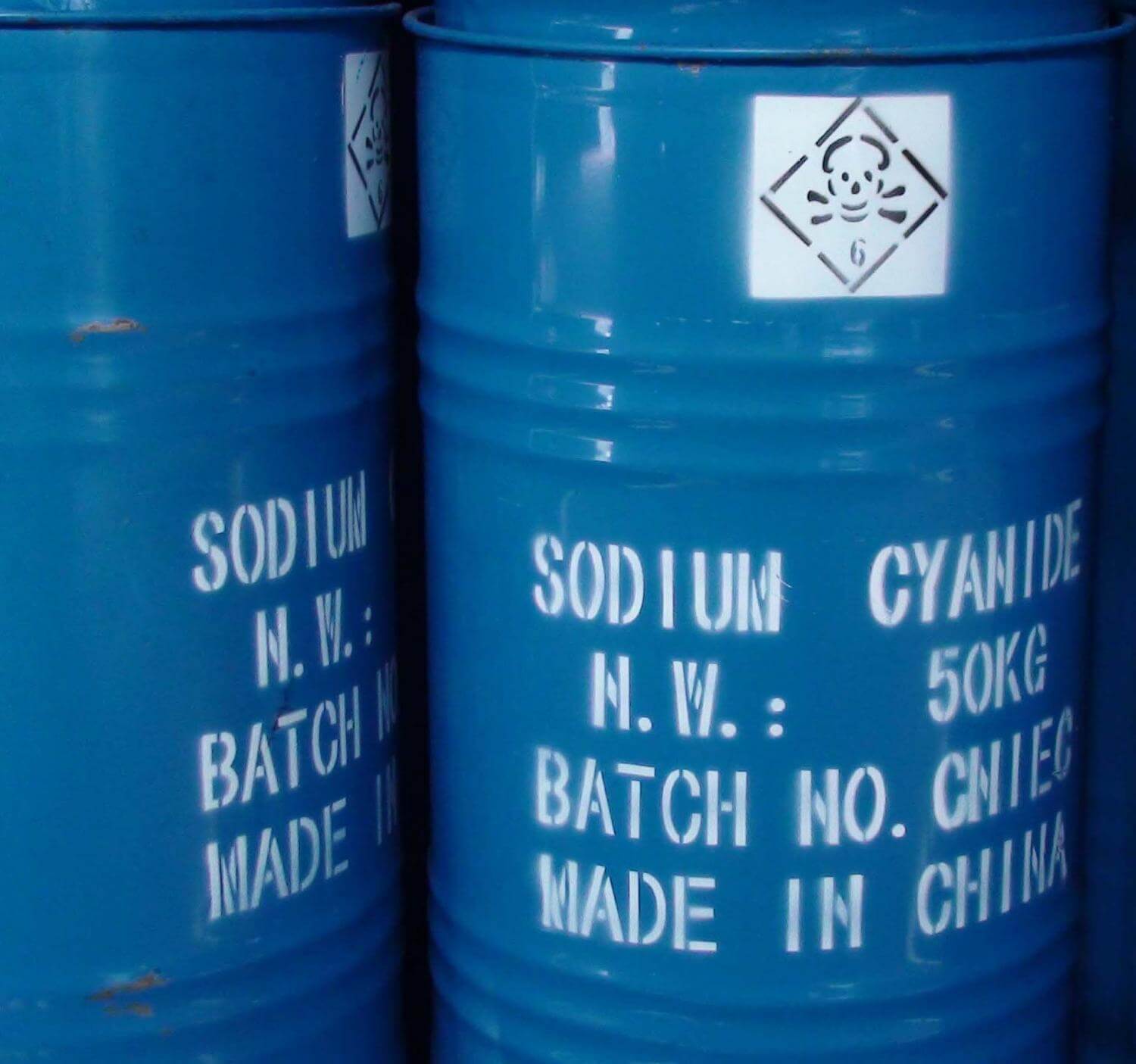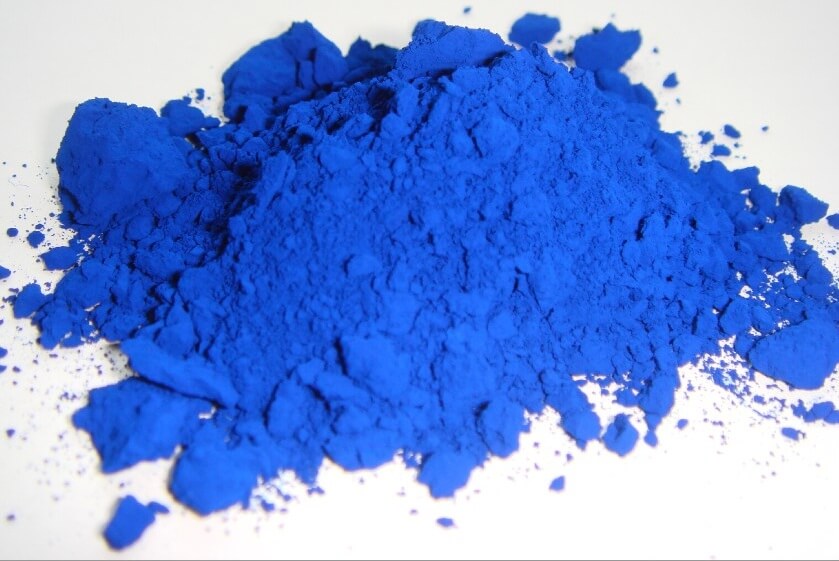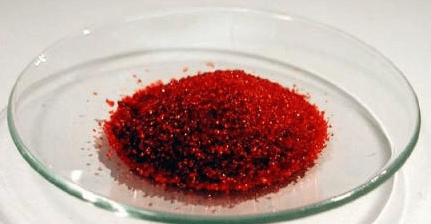Practically all ores treated by the cyanidation process contain iron minerals. In addition, the equipment in cyanidation plants with which cyanide solutions come in contact is made largely of iron and steel. Fortunately, cyanide solutions have very little action on metallic iron and most iron minerals, otherwise the cyanidation process would be impractical for die treatment of precious metal ores.
Cyanides, however, react readily with soluble iron salts, and appreciably with some iron minerals forming numerous cyanogen complexes some of which may be found in mill solutions, and, more rarely in cyanidation residues. Their effect on gold extraction and reagent consumption might be appreciable.
Iron Cyanogen Complexes: The chemistry of iron cyanogen complexes is involved; many are difficult or impossible to prepare in a pure form due to die rapid oxidation of the ferrous compounds, or to the natural acidity of soluble iron salts from which they are prepared, causing loss of cyanide as hydrocyanic acid.
FERROUS CYANIDE Fe(CN)2: This complex may be regarded as ferrous ferrocyanide, Fe2Fe(CN)6, a polymer of Fe(CN)2. In this form the ferrocyanide ion Fe(CN)6== is denoted. By replacement of two of the iron atoms in ferrous ferrocyanide with the equivalent number of calcium, potassium, sodium, manganese, cobalt, copper, nickel, zinc, or silver atoms, the corresponding metal ferrocyanide is formed.
When potassium cyanide solution is added to a solution of ferrous sulphate, the latter in excess, a fine orange colored precipitate is obtained. This complex, however, is not pure ferrous cyanide but a combination of potassium cyanide and ferrous cyanide, KCN*2 Fe(CN)2. When sodium cyanide is used in place of potassium cyanide, the complex, (NaCN)4Fe (CN)2 is formed.
If ferrous chloride is treated with a solution of freshly prepared calcium cyanide, an orange-red precipitate of the pure ferrous cyanide is obtained:
FeCl2 + Ca(CN)2 = Fe(CN)2 + CaCl2
All of these complexes dissolve in excess alkaline cyanide to form alkaline ferrocyanides:
Fe(CN)2 + 4 NaCN = Na4Fe(CN)6
NaCN*4 Fe(CN)2 + 15 NaCN =
4 Na4Fe(CN)6
Ferrous hydroxide reacts with cyanide solutions forming first, insoluble ferrous cyanide or an insoluble complex of the type given above, and then with excess cyanide, to give a soluble ferrocyanide.
FERRIC CYANIDE Fe(CN)3: Simple ferric cyanide probably does not exist, or if it does, it exists as such only momentarily, decomposing to ferric hydroxide and hydrocyanic acid.
Hypothetically, it may be considered as ferric ferricyanide, FeFe(CN)6, a polymer of Fe(CN)3. As such it indicates the ferricyanide ion Fe(CN)6=-. By replacement of the ferric ion in ferric ferricyanide with the equivalent amount of sodium, manganese, nickel, cobalt, or other metals, the corresponding ferricyanides are formed. Soluble cyanides react Avith soluble ferric salts as follows:
3 NaCN + FeCl3 + 3 H2O =
3 NaCl + 3HCN + Fe(OH)3
Ferric hydroxide, as opposed to ferrous hydroxide, does not react with alkaline cyanide solutions. For this reason, if a precious metal ore or calcine contains water-soluble ferric com-pounds such as ferric sulphate, no cyanide is consumed due to their presence, provided that the iron is precipitated as ferric hydroxide by the addition of an alkali before cyanide is added. However, if cyanide solution is added first before precipitating the water-soluble ferric iron, there is danger of losing cyanide as hydrocyanic acid according to the last equation.
COMBINATIONS OF Fe(CN)2 and Fe(CN)3:
By the interaction of ferric salts with ferrocyanides, or of ferrous salts with ferricyanides or ferrocyanides, many complex combinations of ferrous cyanide and ferric cyanide are formed. The best known of these are prussian blue and Turnbull’s blue.
When a ferric salt is added to potassium ferrocyanide in slightly acid solution, a dark blue precipitate of ferric ferrocyanide, (prussian blue) 4Fe(CN)3*3 Fe(CN)2 or Fe4=-
[Fe=(CN)6]3 is formed:
4 FeCl3 + 3K4Fe(CN)6 = Fe4[Fe(CN)6]3 + 12 KCl
The fine or even colloidal precipitate may be flocculated by warming. This precipitate is soluble in alkalis forming ferrocyanide and ferric hydroxide:
Fe4[Fe(CN)6]3 + 6Ca(OH)2 =
4 Fe(OH)3 + 3Ca2Fe(CN)6
When a ferrous salt is added to potassium ferricyanide, a blue precipitate of ferrous ferricyanide (Turnbull’s blue) Fe3=[Fe=-(CN)6]2 or 3 Fe(CN)2*2 Fe(CN)3 is formed:
3 FeSO4 + 2 K3Fe(CN)6 = Fe3[Fe(CN)6]2 + 3 K2SO4
When a ferrous salt is added to potassium ferrocyanide, a white precipitate, turning light blue, of potassium ferrous ferrocyanide, Fe”K2Fe“(CN)6 or 2 KCN*2Fe(CN)2 comes down:
K4Fe(CN)6 + FeSO4 = FeK2Fe(CN)6 + K2SO4
When a ferric salt is added to potassium ferricyanide, no precipitate is formed but the solution turns darker brown in color.
Ferrocyanides have the general formula M4′ Fe(CN)6 where M4′ represents four monovalent atoms or groups which can be replaced either completely or partially by an equivalent number of atoms of other valencies.
The alkali metal and alkaline earth metal and ammonium ferrocyanides are soluble in water. Typical of these are potassium ferrocyanide, K4Fe(CN)6, calcium ferrocyanide Ca2Fe(CN)6, and ammonium ferrocyanide, (NH4)4Fe(CN)6. Others, in which more than one alkaline metal or group are present, are calcium ammonium ferrocyanide Ca(NH4)2Fe(CN)6, and calcium potassium ferrocyanide CaK2Fe(CN)6 (only slightly soluble in water).
The heavy metal ferrocyanides are insoluble in water. As in the case of the soluble ferrocyanides, heavy metal ferrocyanides may contain more than one metal in the M4′ positive radical. Typical heavy metal ferrocyanides are cupric ferrocyanide Cu2Fe(CN)6, nickel ferrocyanide Ni2Fe(CN)6, zinc ferrocyanide Zn2Fe(CN)6, silver ferrocyanide Ag4Fe(CN)6, cupro potassium ferrocyanides Cu2K2Fe(CN)6, Cu3KFe(CN)6, and zinc potassium ferrocyanide ZnK2Fe(CN)6.
SODIUM FERROCYANIDE Na4Fe(CN)4*10H2O:
Formed by the action of sodium cyanide on ferrous compounds:
FeSO4 + 6 NaCN = Na4Fe(CN)6 + Na2SO4 FeS + 6 NaCN = Na4Fe(CN)6 + Na2S
In the presence of oxygen the sodium sulphide is oxidized to thiocyanate:
Na2S + NaCN + H2O + 1/2 O2 = NaCNS + 2 NaOH
Sodium ferrocyanide ionizes thus:
Na4Fe(CN)6 <–> 4Na+ + Fe(CN)6==
The iron hexacyanide ion, however, is ex-tremely stable, the degree of dissociation being practically zero. The following ionic equation demonstrates this point:
Fe(OH)2 + 6 CN~ = Fe(CN)6= + 2 OH’
Otherwise, that is, if any appreciable dissociation of the Fe(CN)6== ion took place, the reaction would proceed to the left and the OH ions would precipitate ferrous hydroxide. Sodium ferrocyanide, in common with other water-soluble ferrocyanides, is practically unaffected by cold dilute hydrochloric or sulphuric acid. Concentrated sulphuric acid decomposes sodium ferrocyanide as follows:
Na4Fe(CN)« + 6H2SO4 + 6H2O =
2 Na2SO4 + 3 (NH4)2SO4 + FeSO4 + 6 CO
Sodium nitroprusside, Na2Fe(CN)5,NO, is formed by the oxidation of potassium ferrocyanide with dilute nitric acid (50 percent) followed by neutralization of the liquid with sodium carbonate. It crystallizes in deep red crystals. This salt is used to detect soluble sulphides, forming an intense violet color when they are present.
Soluble ferrocyanides are oxidized to ferri-cyanide by oxidizing agents such as chlorine, bromine, potassium permanganate:
KMnO4 + 5K4Fe(CN)6 + 4H2SO4 =
3 K2SO4 + 5 K3Fe(CN)6 + MnSO4 + 4H2O
Soluble ferrocyanides are relatively stable when the solutions are exposed to the air. For this reason they do not consume the oxygen in cyanide solutions and it is unlikely, therefore, that they will retard the dissolution of gold or silver. In fact, it has been claimed that potassium ferrocyanide in the presence of oxygen is a weak solvent for gold:
3 Au + K Fe(CN)6 + 2 H20 + 02 =
3 KAu(CN)2 + Fe(OH)3 + KOH
Under some conditions when a mill solution containing ferrocyanide or ferricyanide is exposed to sunlight, the solution turns a light purplish color, very similar in appearance to colloidal gold and premature precipitation of gold has been suspected in some cases. However, when kept in the dark for some time, the color disappears. This phenomenon was investigated and showed that when a solution containing ferrocyanide is exposed to light in the presence of a small amount of calcium cyanamide, a photochemical change takes place; the ferrocyanide dissociates into a pentacyano compound and free cyanide according to the following equation:
Light
K4Fe(CN)6 <———————–> K3Fe(CN)5 + KCN
Dark
 The pentacyano compound reacts with calcium cyanamide forming a penta-cyanocyanamide addition compound which is wine colored. In the dark the reaction is reversed, the pentacyano compound and cyanide combining to form ferrocyanide whereupon the solution becomes colorless.
The pentacyano compound reacts with calcium cyanamide forming a penta-cyanocyanamide addition compound which is wine colored. In the dark the reaction is reversed, the pentacyano compound and cyanide combining to form ferrocyanide whereupon the solution becomes colorless.
As would be expected from the equation given, the addition of free cyanide hinders the formation of the pentacyano compound and consequently lessens the color produced in light. Practical observations have shown that this color phenomenon is experienced only in those cyanide solutions where the free cyanide is unusually low. Sodium ferrocyanide reacts with solutions of various heavy metal salts to produce insoluble heavy metal ferrocyanides. For example, the addition of silver nitrate to ferrocyanide precipitates white curdy flocks of silver ferrocyanide:
Na4Fe(CN)6 + 4AgNO3 =
Ag4Fe(CN)6 + 4NaNO3
SILVER FERROCYANIDE Ag4Fe(CN)6: Is soluble in cyanide solutions:
Ag4Fe(CN)6 + 8 NaCN = 4NaAg(CN), + Na4Fe(CN)G
It is also soluble in ammonia forming probably a silver ferrocyanide ammoniate, Ag4Fe(CN)e*NH3.
ZINC FERROCYANIDE Zn2Fe(CN)6*6H2O:
Prepared by adding zinc chloride to a soluble ferrocyanide, preferably calcium ferrocyanide. It is white, insoluble in dilute acids and am¬monia but soluble in cyanide solutions and caustic soda:
Zn2Fe(CN)0 + 8 NaCN = 2Na2Zn(CN)4 + Na4Fe(CN)c
Zn2Fe(CN)G + 8 NaOH =
2 Na2Zn02 + Na4Fe(CN)c + 4 H20
CUPROUS FERROCYANIDE:
The existence of cuprous ferrocyanide in the simple form Cu4Fe(CN)6 is doubtful but the double salts Cu3KFe(CN)6 and Cu2K2Fe(CN)6 are said to be formed by the action of cuprous cyanide or cuprous chloride on potassium ferrocyanide solution in the presence of a reducing agent such as potassium sulphite. These salts are white or colorless and oxidize rapidly to the reddish brown cupric salts.
CUPRIC FERROCYANIDE Cu2Fe(CN)6:
Prepared from cupric salts and potassium ferrocyanide. The product is reddish-brown containing varying amounts of water. This salt always contains potassium which may be due to the adsorption of K4Fe(CN)6 or to the formation of the double salt CuK2Fe(CN)6*2 H20.
It is only slightly soluble in dilute acids but dissolves readily in caustic soda, ammonia or alkaline cyanides:
Cu2Fe(CN)6 + 4 NaOH =
Na4Fe(CN)6 + Cu(OH)2
Cu2Fe(CN)6 + 8 NaCN =
2 Na2Cu(CN)3 + Na4Fe(CN)6 + (CN)2
In the case of ammonia, a soluble cuprammonium complex is probably formed.
FERRICYANIDES:
Ferricyanides have the general formula M3’Fe(CN)6 where M3′ represents three monovalent atoms or groups which can be replaced either completely or partially by an equivalent number of atoms of other valencies. Thus the ferricyanides are similar to the ferrocyanides in general structure. Ferricyanides are similar to ferrocyanides in that the alkali ferricyanides are usually water-soluble and the heavy metal ferricyanides are insoluble. As in the case of heavy metal ferrocyanides, the heavy metal ferricyanides are of various colors.
POTASSIUM FERRICYANIDE. K2Fe(CN)4: Prepared by passing chlorine into a solution of potassium ferrocyanide:
2K4Fe(CN)6 + Cl2 = 2K3Fe(CN)6 + 2 KCl
The solution is intense yellow in color but on crystallization yields deep red anhydrous crystals. It ionizes to the ferricyanide ion Fe (CN)0E which is very stable although not quite as stable as the Fe(CN)(i= ion. Potassium ferricyanide is decomposed by hot, dilute sulphuric acid to hydrocyanic acid. A cyanide solution containing potassium ferricyanide dissolves gold in the absence of oxygen:
K„Fe(CN)6 + 2 KCN + Au = K4Fe(CN)6 + KAu(CN)2
Potassium ferricyanide in slightly acid solutions reacts with potassium iodide forming the ferrocyanide and free iodine. This reaction is used for the quantitative determination of ferricyanides:
K3Fe(CN)6 + KI = K4Fe(CN)6 + I
Ferricyanides are reduced to ferrocyanides in alkaline solution by sulphites and sulphides:
2 K3Fe(CN)6 + K2S = 2 K4Fe(CN)6 + S
The doube salt, K2NaFe(CN)6, may be formed by crystallizing a solution of sodium ferricyanide and potassium chloride:
Na3Fe(CN)6 + 2KCl =
K2NaFe(CN)6 + 2 NaCl
Alkali ferricyanides react with solutions of heavy metals usually precipitating highly-colored heavy metal ferricyanides. Lead ferricyanide is an exception; it is white and very soluble in water. For example, when silver nitrate is added to potassium ferricyanide, an orange-yellow precipitate of silver ferricyanide comes down:
K3Fe(CN)6 + 3 AgNO3 =
Ag3Fe(CN)6 + 3 KNO3
This precipitate is readily soluble in cyanide and in ammonia. The addition of cuprous chloride to ferricyanide gives a reddish-brown precipitate of uncertain composition which is soluble in cyanide and in ammonia. Cupric ferricyanide is precipitated when cupric sulphate is added to potassium ferricyanide:
3 CuSO4 + 2K3Fe(CN)6 = Cu3[Fe(CN)6]2 + 3 K2SO4
It is brownish yellow, soluble in cyanide solutions and soluble in ammonia. Zinc ferricyanide, Zn3[Fe(CN)6]2, is light yellow, soluble in cyanide solution and soluble in ammonia. In the last respect it differs from zinc ferrocyanide.
FERRIC THIOCYANATE Fe(CNS),: When a slightly acid solution of a ferric salt is added to a soluble thiocyanate, an intense dark red color is produced due to the formation of soluble, non-ionized ferric thiocyanate:
Fe2(S04)3 + 6 NaCNS =
2 Fe(CNS)3 + 3 Na2SO4
This is an exceedingly sensitive test for ferric iron, and conversely, for thiocyanate. This test may he used for the quantitative determination of iron or thiocyanate.
